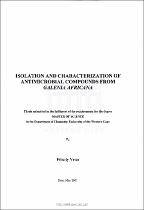| dc.description.abstract | Galenia africona, commonly known as "kraalbos" or "geelbos" belonging to the family Aizoaceae, is a dominant plant throughout the Namaqualand area. It is an active invader and is especially abundant in disturbed areas around kraals, along roads, and water points which shows that it grows well on trampled soil. "Kraalbos" is not very palatable to livestock, but is grazed under pressure. The plant can cause liver damage and severe ascites, a condition referred to as "waterpens" in sheep and occasionally in goats. The Hottentots chew the plant to relieve toothache and it is said to blister the mucous membrane of the mouth if used too much. The plant was also used in the treatment of veneral diseases.
Dried samples of G. africana collected in Steinkopf and Concordia were sequentially extracted with various solvents starting with hexane, chloroform, ethanol and sterile distilled water. Each concentrated extract were tested for its inhibitory activity against fungi and bacteria by using the agar well diffusion method. The mycelial growth of Fusqrium graminearum and Fusarium verticillioides cultured on PDA was inhibited by the CHCI3 and EtOH extracts. The minimum inhibitory concentration (MIC) of these two extracts was calculated for both fungal and bacterial species. Overall results showed that the EtOH extract from G. africana has strong inhibitory activity in vitro against fungi and bacteria. The above findings advocate further investigation of the EtOH extract. It will be necessary to identiff the active components and to evaluate their potential for use as antimicrobials.
The ethanol extract was purified using silica gel column chromatography and thin - layer chromatography. Four fractions showed significant antifungal activity as evidenced by a clear zone of inhibition. One fraction was tested against a range of fungi and a few bacterial isolates. This fraction inhibited the growth of most of the fungal isolates with Alternaria sp., Fusarium equiseti, F. gramineorum, F. verticillioides and Phaeomoniella clamydospora being the most sensitive ones. Both Bacillus sp. and Staphylococcus atffeus were inhibited in the presence of the fraction. The MIC's for fungi showed values ranging from 10 to 2.5% and bacteria from 2.5 to 1.25 %. The active fraction inoculated onto individual filter paper disks displayed potent antifungal activity on agar plates seeded with conidia of the various fungal isolates being tested. The filter paper disk method showed more sensitivity than the agar well diffusion method in the detection of the antifungal activity of the active fraction. | en_US |

